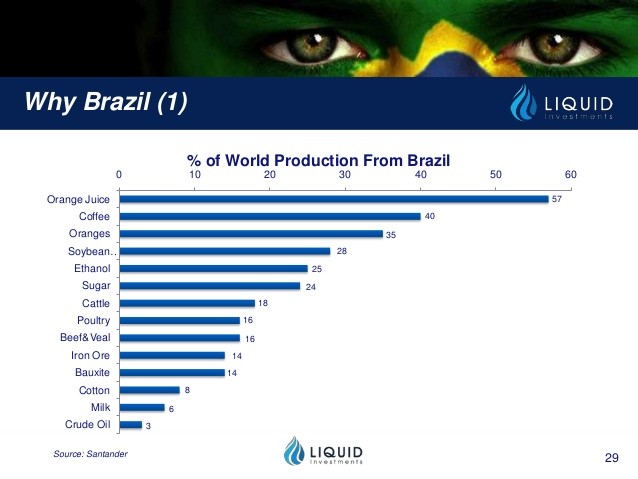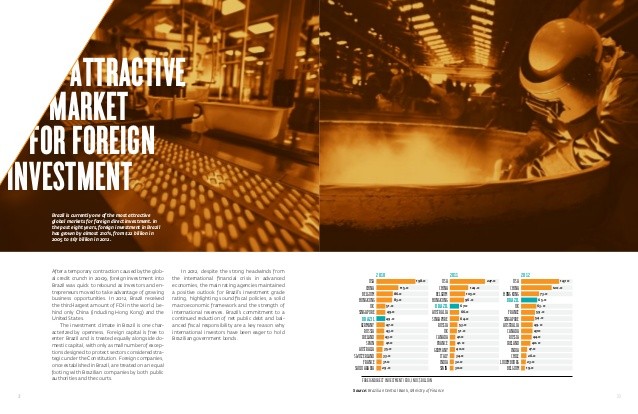Investing in Brazil_1
Post on: 18 Июнь, 2015 No Comment

Investing in Brazil
Brazilian stocks are hot! According to StocksAbroad.com. an index of Brazil stocks traded on U.S. exchanges has gained 83% over the past 12-months compared to a 6 % drop in the S&P 500.
Characterized by large and well-developed agricultural, mining, manufacturing, and service sectors, Brazil’s economy outweighs that of all other South American countries and is expanding its presence in world markets , according to the CIA World Factbook (www.cia.gov ).
Brazil exports commodities such as beef, iron ore, steel, ethanol, soybeans, and coffee. many of which are trading near record levels. In fact according to MSN Money’s Jon Markman, Brazil is the world’s biggest exporter of raw materials. The global demand for Brazil’s exports is fueling strong economic growth.
Turnaround Story
Close to bankruptcy in 2002, Brazil is a turnaround story and many Brazil stocks got a boost in April when Standard & Poor’s raised the country’s debt rating to investment grade, signaling an end to its earlier economic problems. Brazil stocks are expected to receive another boost when credit rating agencies Moody’s and Fitch follow S&P’s lead and hike their credit ratings, a move expected later this year.
Until recently, based on its earlier economic problems, investors mostly shunned Brazil stocks. Consequently, despite the recent share price run-up, many analysts believe that they have plenty of room left to run.
Mutual Funds & ETFs
Exchange-traded funds (ETFs) or conventional managed mutual funds are the easiest and safest way to invest in foreign markets (ETFs are similar to index mutual funds, except they trade like stocks).
Currently, in terms of mutual funds and ETFs, the iShares MSCI Brazil Index ETF (ticker EWZ ) is the only available pure play on Brazil. It tracks an index comprised of 71 stocks, mostly materials, energy and bank stocks. The fund, up 25% year-to-date, has soared 75% over the past 12-months and gained 67%, on average, annually, over the past three years.
You’ll have more choices if you’re willing to diversify somewhat, in terms of countries.
Latin America Funds
The iShares S&P Latin America 40 Index ETF (ILF ) tracks an index with stocks in other Latin American countries, mostly Mexico and Chile, as well as Brazil. However, Brazil stocks make up 66% of the portfolio. The fund is up 23% year-to-date, and has returned 49% over the past 12-months. Its three-year average annual return is 55%.
A newer ETF, SPDR S&P Emerging Latin America (GML ), tracks an index containing 96 stocks, so it’s more diversified than the 40 stock iShares Latin America fund. It also overweights Brazil, with that country representing 63% of its portfolio. The fund, up 20% year-to-date, and 43% over the past 12 months, hasn’t been around long enough to rack up a three-year track record.
If you prefer an actively managed conventional mutual fund, T. Rowe Price Latin America (PRLAX ) holds 46 stocks, with Brazil representing 65% of its portfolio. The fund, up 17% year-to-date, has returned 41% over the past 12-months, and has averaged a 56% annual return over three years.
Finally, Fidelity Latin America (FLATX ), another actively managed fund, holds 64 stocks, with Brazil representing 60% of its portfolio. The fund is up 16% year-to-date, and 40% over the past 12 months. Its three-year average annual return is 54%.
Finding Brazil Stocks
If you want to pick Brazil stocks on your own, BuyUpside.com (www.buyupside.com ) maintains a list of Brazil stocks that are traded on U.S. Exchanges. When I looked, the site listed 35 stocks, and included a link to Reuters’ business description for each stock. The Reuters’ descriptions are quite detailed, and tell you more than you probably want to know about each company’s business. Find the list from BuyUpside.com’s homepage by selecting Portfolios and then selecting Brazilian Stocks.
StocksAbroad.com also lists Brazil stocks traded on U.S. exchanges. Find it by selecting Brazil from the Latin America section on StocksAbroad.com’s homepage. That will take you to the Brazil homepage, which displays the chart showing U.S.-listed Brazil stock’s performance vs. the S&P 500 index that I mentioned earlier. That page also displays current news stories about Brazil stocks that I found quite helpful. Click on the “Brazil ADR ” link to see the list of stocks.
The 10 biggest stocks in terms of company size (market capitalization) include

O il and natural gas producer Petroleo Brasileiro (PBR),
M etals mining operator Vale (RIO),
B ank operators Bradesco (BBD) and Banco Itau Holding Financeira (ITU),
B eer and non-alcoholic beverage maker Companhia de Bebidas Das Americas (ABV),
T elecom services provider Telecomunicacoes de Sao Paulo S.A. (TSP), and














